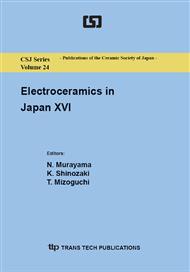p.15
p.19
p.23
p.27
p.32
p.36
p.40
p.44
p.51
Microstructure Control of Porous Barium Titanate Ceramics and their Sensor Properties
Abstract:
Porous barium titanate (BaTiO3, BT) ceramics were prepared by a conventional sintering method using two kinds of BT particles. The relationship between pore structure (porosity and pore size) of BT ceramics and their sensor properties was investigated. Since a piezoelectric d33 constant of BT depends largely on the pore structures, the microstructure control of porous BT ceramics is important to improve the figure-of-merit (g33/ρ). In this study, the maximal piezoelectric g33 constant value of 14.8×10-3 V·m·N-1 and the maximal g33/ρ value of 3.14×103 V·m4·N-1·g-1 were recorded at a porosity of approximately 23%.
Info:
Periodical:
Pages:
32-35
Citation:
Online since:
September 2013
Price:
Сopyright:
© 2014 Trans Tech Publications Ltd. All Rights Reserved
Share:
Citation:


